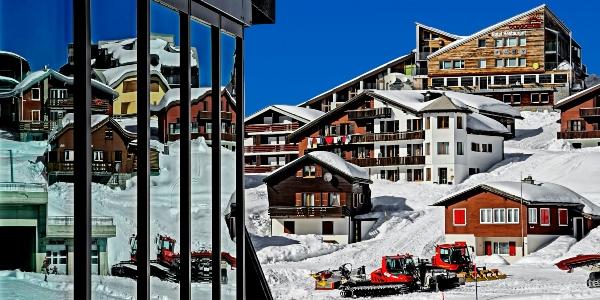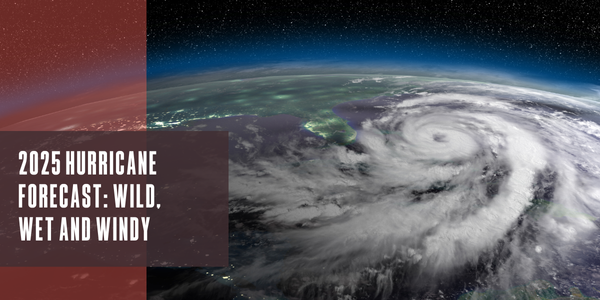The hidden dangers snowstorms pose to your roof

By Curt Liscum, Benchmark.
A storm's fury doesn't just vanish — it lingers on your roof.
When the snow starts falling and the winds begin to howl, your roof bears the brunt of winter's wrath. But what happens to that roof after the blizzard fades? With billions of dollars in damages each year, understanding how snowstorms and blizzards impact the lifespan of your roof is more crucial than ever. From excessive weight to ice dams and wind damage, these winter adversaries can wreak havoc on low-sloped roofs, leading to costly repairs or even catastrophic failures. At Benchmark we look into the unseen battles your roof faces and explore the strategies to keep it standing strong through the fiercest storms.
How do snowstorms or blizzards affect the life of a roof?
According to the National Oceanic and Atmospheric Administration (NOAA), winter storms cause about $1.9 billion in damage on average each year. In 2021, winter storms caused about $24 billion in damage, the highest amount on record. This article will explore the types of damage that may occur to a low-sloped roof during a winter storm and what recourse is available to mitigate those damages.
For a snowstorm to be classified as a blizzard, it must meet the criteria of including heavy or blowing snow, sustained winds of 35 mph and visibility of one-quarter mile or less. The frequency of winter blizzards is increasing. According to research from Ball State University in Muncie, Indiana, from 1960 to 1994, the United States averaged about 9blizzards per year. Since 1995, the average has been19 blizzards a year. Although the Northeast receives much of the national media attention regarding blizzard activity, the largest and most consistent area of higher annual blizzard activity occurs in the northern Great Plains. There is a distinct blizzard zone in North Dakota, western Minnesota and northern South Dakota. Only six states in the contiguous United States (Alabama, Florida, Louisiana, Mississippi, South Carolina and Tennessee) do not have any officially reported blizzards.
As you may recall in February 2021, the Polar Vortex, Texas Freeze, impacted 22 states from Texas to Iowa and North Carolina to Washington. According to the Insurance Information Institute this single winter storm caused a record $15 billion in insured losses and over200 fatalities.
Let us explore the ways in which a winter storm or blizzard can damage a low-sloped roof and thereby decrease its serviceable life expectancy. Four of the most common ways a winter storm can contribute to compromising a roofing system are:
- Excessive weight – Snow, ice and water accumulation
- Ice dams
- Wind damage
- Roofing material degradation
Excessive weight
The high winds of a winter storm can carry snow and deposit it in very inconvenient locations, such as along walls and at changes in roof elevation, creating deep heavy snow drifts. Low sloped commercial roofs are an ideal place for snow drifts to form. Heavy snow, ice and water accumulation can increase the risk of structural collapse of the roof. Standing water can penetrate the roof membrane and cause moisture issues both within the roof assembly and building interior. As ice breaks away from a roof, it can take parts of the roof with it and cause membrane puncture and tearing damage. Snow buildup can be dangerous and cause the roof to sag and even collapse under the extra weight, which can lead to injuries, not to mention the closure of the business.
According to FEMA’s Snow Load Safety Guide, the weight of one foot of fresh snow ranges from 3 pounds per square foot (psf) for light dry snow to 21 psf for wet heavy snow. A single cubic foot may not seem like an extreme amount but spread over a 10,000-square-foot roof area the weight can total over50 tons of snow. Even if the low-sloped roof is rated for “normal” snowfall in its respective area, this amount of weight can really take a toll on the roof and building’s structural components.
It is difficult to minimize snow drifts; it is simply not practical to install a snow fence on the roof. The best thing for a low-sloped roof is to have the snow removed as quickly as possible when there is a confirmed structural overload condition. However, snow removal must be done carefully and with extreme caution to protect the workers removing the snow and to protect the roof membrane. For more information about developing a snow removal plan please see the article titled “Reduce the Risk for Roof Collapse: Planning for Snow Removal.” At the very least, it is recommended building owners contact a professional snow removal company with experience in snow removal from low-sloped roofs before proceeding with any snow removal project.
One simple maintenance activity that can greatly minimize snow, ice and water accumulation is to make sure that all drainage devices (drains, scuppers, gutters and downspouts) are free of debris and free flowing. Allowing water to exit the roof as quickly as possible is the primary factor in reducing ponding conditions.
Ice dams
A definite threat in colder climates, ice dams can occur on both steep sloped and low sloped roofs. An ice dam is a ridge of ice that forms on a roof (at edges or at drainage devices) and prevents melting snow (water) from draining off the roof. The water that backs up behind the dam can leak into the building and cause damage to walls, ceilings, insulation and other building components.
Ice dams are caused by nonuniform roof surface temperatures. Heat loss from a building, snow cover and outside temperatures interact to form ice dams. For ice dams to form there must be snow on the roof, at the same time, higher portions of the roofs surface must be above 32°F (freezing) while lower surfaces are below 32°F. The snow on the roof surface that is above freezing melts and as the water flows down the roof it reaches the portion of the roof that is below 32°F and refreezes.
Ice dams grow as they are fed by the melting snow above, but will limit themselves to the portions of the roof that average below 32°F. So, the water above backs up behind the ice dam and remains a liquid. This water finds cracks and openings in the roof membrane and flows into the building, causing damage to building components.
Ice dams can occur when melting snow has formed around a restricted drainage device (gutter, downspout, scupper or drain). Preventative maintenance for ice dams includes making sure the roof’s drainage systems are clear and free of debris. Additionally, check the roof’s insulation to make sure there are no warm spots on the roof surface that are causing snow to melt. A warm area will melt snow and ice, only for it to freeze again when it reaches a colder place on the roof.
Wind damage
Severe winter storms are often accompanied by high winds. High winds can cause significant roof damage in the form of displaced membrane and metal components, scouring of surfacing materials, billowing or displacement of flashings and puncture damage from rooftop equipment and utilities becoming wind-borne debris. Once displaced, torn or punctured, moisture can enter the roof causing all sorts of havoc to occupants, disruption to operations and damage to building components.
We cannot stop the wind, but we can take precautions to give the roof a fighting chance. Prior to the onset of winter weather is a great time to have the roof inspected and address any issues. A roofing professional, experienced in the assessment of a roof, will check for any loose material, ponding water and any flashings or fasteners that might be loose or deteriorated. The inspector will also check the areas around the roof’s penetrations, like HVAC systems or skylights, to make sure that there are no roofing issues to be addressed.
Roofing material degradation
Even though roof technology and science have taken us a long way from roofs of old, there is still no such thing as a permanent roof. Even the longest-lasting metal roofs will eventually need to be replaced with a new roof. Materials degrade over time and in areas with harsh winters, the continuous freeze / thaw cycle can be brutal.
Roofing material degradation is inevitable and an important consideration. Roofing material failure can not only lead to the previously mentioned winter issues, but it can also cause problems to appear at any time of the year making semi-annual inspections of the roof crucial to maximizing serviceable life. Preventative maintenance inspections allow us to stay up to date on the condition of the roof and allow for advanced planning and budgeting. Keeping a roof well-maintained can help to avoid costly roof repairs in the future. However, if roof repairs are unavoidable, make sure to have them completed as soon as possible using a qualified professional roofing contractor. Roof problems only get larger and worse as time passes.
Minimizing winter roof damage
The best method to minimize low-sloped roof damage during the winter season is advanced planning and preparedness. Establishing a roof maintenance plan, having regular inspections and scheduling preventative maintenance are the best ways to extend the lifespan of your roof, prevent costly roof replacement and minimize winter storm damage. If you are interested in discussing how to minimize damage from winter storms, please contact Benchmark.
Original article and photo source: Benchmark
Learn more about Benchmark in their Coffee Shop Directory or visit www.benchmark-inc.com.























Comments
Leave a Reply
Have an account? Login to leave a comment!
Sign In